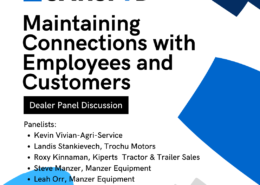Heavy equipment dealers have some of the highest customer satisfaction scores when compared to other industries with a range averaging between 70 and 80 Net Promoter Score! Their attention to meeting and exceeding customer expectations is key to achieving these high scores. Understanding customer needs and responding to issues plays a large role in creating loyal customers. Farm Equipment’s 2017 Brand Loyalty Study reveals that while the foundation of customer loyalty begins with a good product, loyalty is strengthened and solidified by strong post-sale parts and service support. They shared that, “41% of respondents mentioned the customer not being prioritized by the previous dealership as a key factor for the switch” to another dealer.
Delivering service that meets customer’s expectations requires awareness and understanding by all employees in your dealership. Implementing a structured feedback loop is one way to give you the information you need to translate that feedback into action. ‘Over the counter’ feedback is important but can often be lost without a formal process for documentation and follow up. And, any thoughts the customer have once they’ve left the dealership may not be shared without a specific request, such as through a survey or phone call.
“41% of respondents mentioned the customer not being prioritized by the previous dealership as a key factor for the switch” to another dealer.
There are a number of things to consider when deciding on whether to create a home-grown survey system or adopt one developed by customer feedback professionals: Dealership culture, resource availability and skills, survey process purpose goals and objectives, effort to maintain the process, and ultimately which customers you wish to survey. We’ve assembled key considerations to help you decide whether an in-house or 3rd-party approach is the best fit for implementing a formal customer feedback loop at your dealership.
Purpose
Deciding on an approach for collecting customer feedback might seem daunting. One straightforward method is to start with your end result in mind and work back to where you are today. Consider the following when evaluating your dealership’ best-fit solution:
Once you have the answers to these questions you have the information to frame your goals for implementing a customer feedback loop. We’ve created three samples to help you get started:
Goal 1. Uncover Customer Issues and Focus on Resolution
To identify as soon as possible any issues that may have occurred during a visit to our store, website or during a phone call, so that our employees can work to correct that issue to prevent recurrence and improve the customer experience going forward. (Survey all customers, regularly, to understand customer experience in all divisions and locations.)
Goal 2. Retain More Customers: Assess and Improve
To continually learn customer’s thoughts and opinions on their experience with our dealership so that we can improve our customer experience and loyalty.
Goal 3. Input on New Initiative
To create a one-time survey that identifies whether offering a new service such as a new financing option is something customers would find appealing and would take advantage of it.
Personas
When collecting feedback, it’s important to know who you are surveying and how often. While learning the thoughts and opinions of all customers gives you a complete picture of your dealership’s customer experience, the time and effort devoted to this can be overwhelming with diminishing returns. Think 80-20. Take time to identify the different customer types that you want to hear from and create a persona for each of them. For example, owner-operator, farm owner, and corporate enterprise farmer.
A customer persona is a semi-fictitious representation of a large segment of your customer base that describes their demographics, behavior, motivations, and goals. Personas bring clarity to your customer experience and marketing efforts by providing all employees with a shared understanding of your priority customers.
Personas can help create a positive impression and get a good return rate on your surveys by learning your customers’ preferred method of communication. Some customers respond better to traditional paper surveys while others prefer electronic contact. Identify for each persona how they wish to be contacted: e.g., email, text, paper, and phone survey methods.
Surveying customers is a learning process. Remember to be flexible and allow yourself to change methods if you aren’t getting the results you want.
In-House or 3rd-Party Initiative
What’s Best for Your Dealership?
A Look at Resources
The resource commitments for In-house and 3rd-party customer feedback solutions are vastly different.
Within your organization you already may have resources that understand proper survey methods and the different survey applications and technology available in today’s market. But do they have the capacity within their daily responsibilities to create and distribute customer surveys and reports based upon returned surveys? Identify these resources and their available time to determine whether you need to hire or contract additional staff. This is also a good time to evaluate the available data storage and processing capacity of your network to determine whether you’ll need to purchase additional network servers and components.
Third-party solutions do the heavy lifting for you. Once the surveys are set your resources can focus on responding to the feedback contained within the returned surveys and identify trends from advanced reports and analytics generated by these systems. An important and significant feature offered by 3rd-party systems is they calculate a customer satisfaction score that accurately measures customer experience at your dealership. By monitoring changes to this score you can respond quickly and reinforce processes when scores go up, or dive in to understand why scores are declining.
Resource Requirements by Goal
Resource requirements vary further based upon the goals and objectives for your customer feedback solution. Consider the decision criteria for the three sample goals when evaluating your options.
Goal 1. Be More Customer-Centric: Uncover Customer Issues and Focus on Resolution
Uncovering customer issues and focusing on resolution is an everyday effort. To minimize the impact on your resources it’s important that processes are automated and repeatable. Steps to uncover and resolve customer issues include:
The size of your organization and the number of surveys you anticipate sending each day will determine your resource requirements. Typically dealers will need the following for an efficient repeatable in-house survey process:
For ongoing collection of customer feedback, we recommend implementing a 3rd-party solution such as SATISFYD. They bring tools that integrate with your business systems transactional data to trigger surveys in the distribution method of your choice. Their cloud-based technology adds no additional servers or equipment to your network. Using pre-defined time-tested questions provides a benchmark to measure your performance against others in your industry. In addition, you have access to advance reports to help you easily identify experience areas you can improve with both NPS and CSI scoring.
The resources needed to support a 3rd-party system is significantly less than for in-house developed systems. Dedicate a few hours a week of one employee’s time to review flagged surveys and follow-up with customers to close the loop on any concerns.
The key here is by using outside experts, your staff are freed to address customer feedback, resolve issues and modify internal processes that further enhance customer experiences. They are not spent performing repetitive administrative tasks – generating surveys and producing and distributing reports.
Goal 2. Retain More Customers: Assess and Improve
This goal is similar to Goal 1 but is implemented on a smaller scale. This effort is more project-based and collects customer feedback on a quarterly, bi-annual, or annual basis, surveying all customers at one time. These surveys require the same processes and resources as an ongoing effort, but for a shorter period of time.
We again recommend using a 3rd-party. An industry expert can help you assess the current state and learn what’s changed over the prior year. Their reporting tools allow you to compare trends over time, location, and department to understand what needs attention and how process improvement changed customer experiences. Use these insights to align feedback trends with strategic plans.
Goal 3. Input on New Initiative
Goal 3 is a simple and suitable task to do in-house. Getting input on a new initiative can be accomplished using a straightforward and short survey that doesn’t require advanced reporting or much data storage. There are many free online survey tools available today, such as SurveyMonkey and MailChimp. Tools like these are great for surveys with a specific question that looks for a specific actionable answer. Help from your IT resources to export customer contact information to upload to your survey distribution site may still be required.
Third-party solutions are also appropriate for collecting feedback on a new initiative! For industry-leading and exploratory questions, 3rd--party expertise can help develop questions that lead to meaningful answers as well as to confirm accuracy and completeness – white glove guidance as you go through the process. In addition to providing reporting and analytics, they may be able to shed some light on trends and best practices, added value to help you understand what customers are saying and the reasoning behind it.
Company Adoption and Making It Stick
Ultimately, collecting customer feedback is not the end in itself, it is the means to the end to create a customer-centric environment within your organization.
Take a look at your organization’s culture and identify changes needed to make the feedback a trusted and valuable part of your operating and strategic data. Reinforce to all employees the importance of considering customer feedback ‘mission critical’, and encourage them to offer improvements during team, department and dealership meetings.
Ensure managers are using the feedback to identify trends and areas for growth and improvement. Make this information an important part of your business strategy and efforts to improve your dealership. Schedule quarterly reviews and implement changes based on results. Share best practices between locations to help the entire organization improve.
Accepting the new process and stream of information into your organization will take time and regular communication about its benefits. Using a method that lets you identify trends and track improvements in scoring gives your employees’ tangible feedback about their efforts. Consider using those results in your employee recognition or incentive programs. Make it something they strive to achieve. Share scores between departments and locations to create friendly competition. To learn more about how other dealers incorporate this, download our eBook here!







